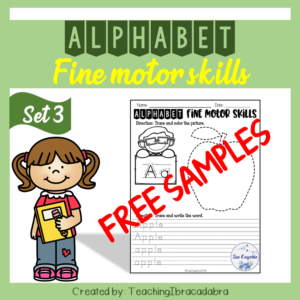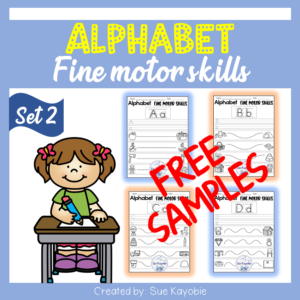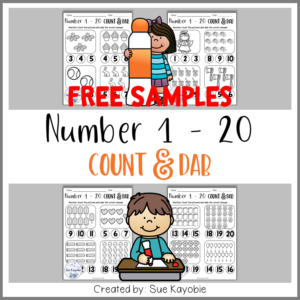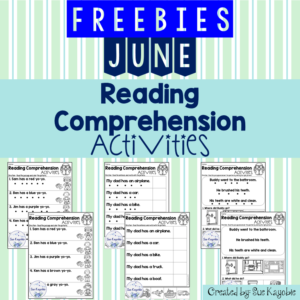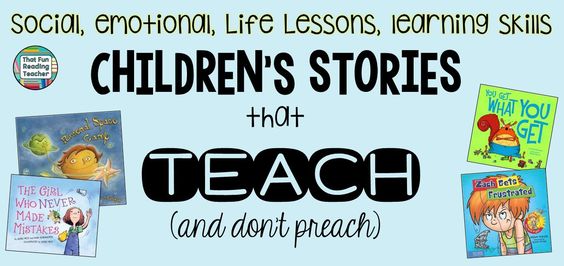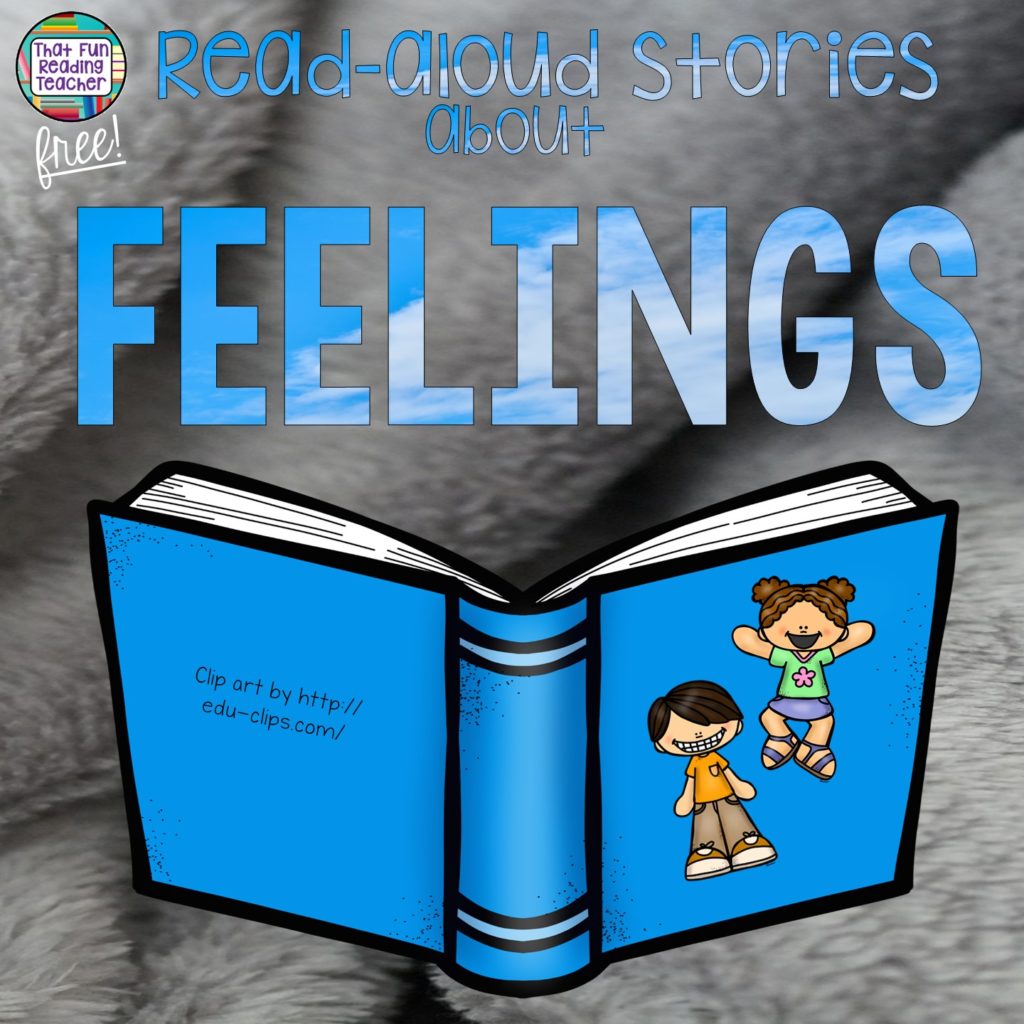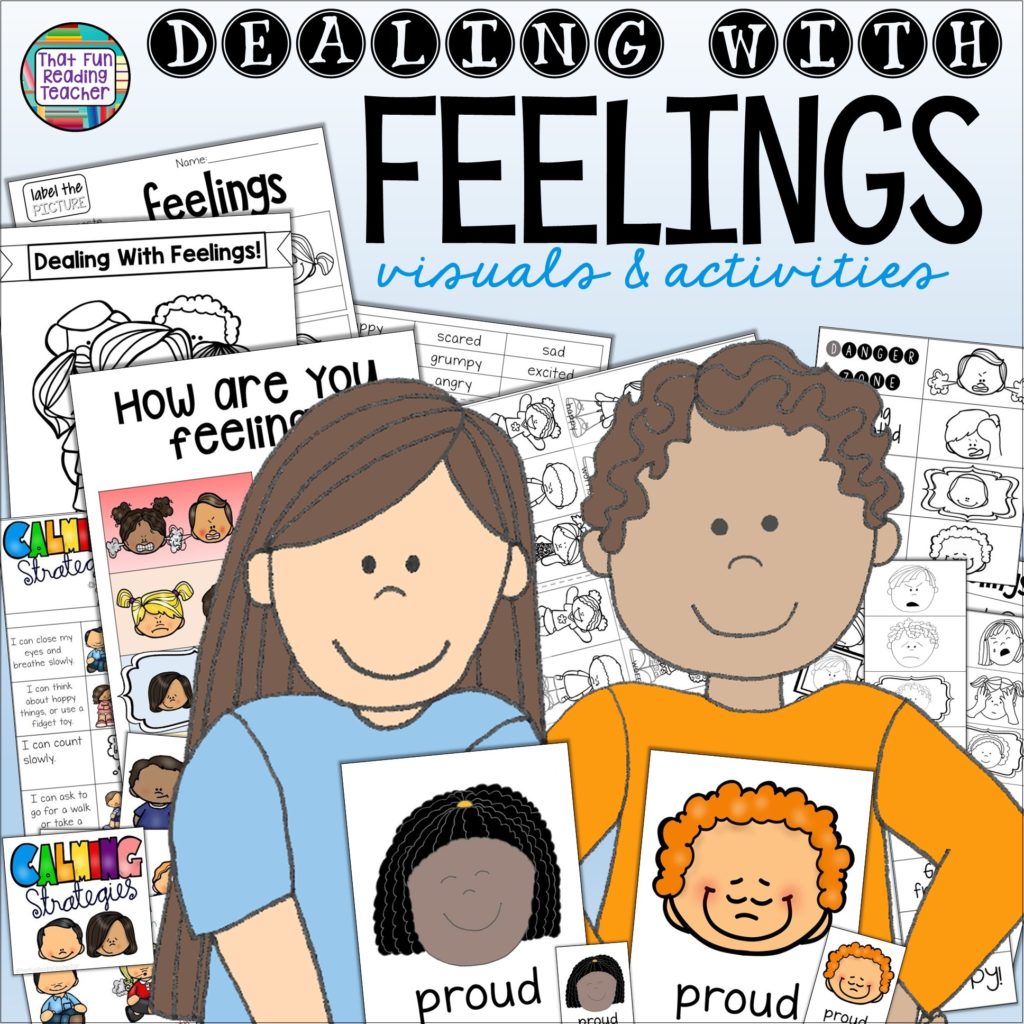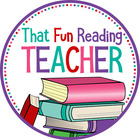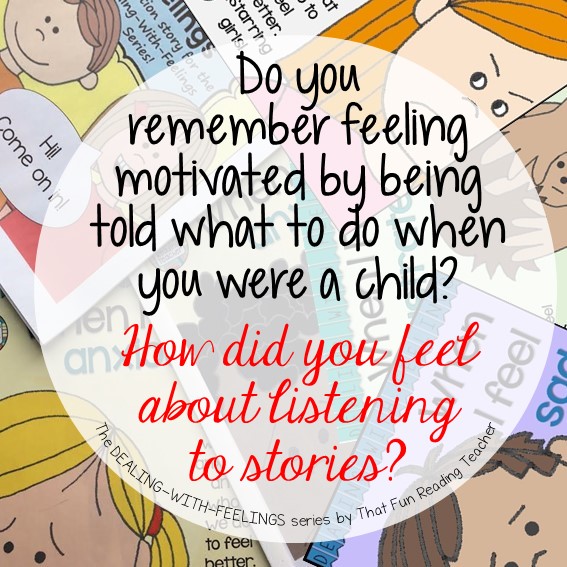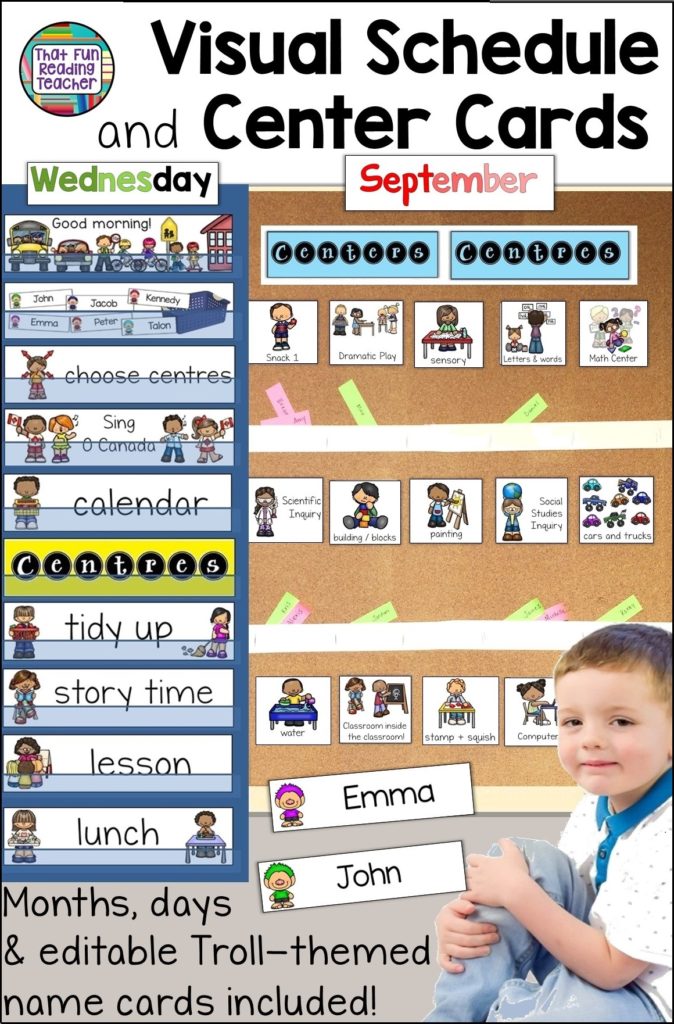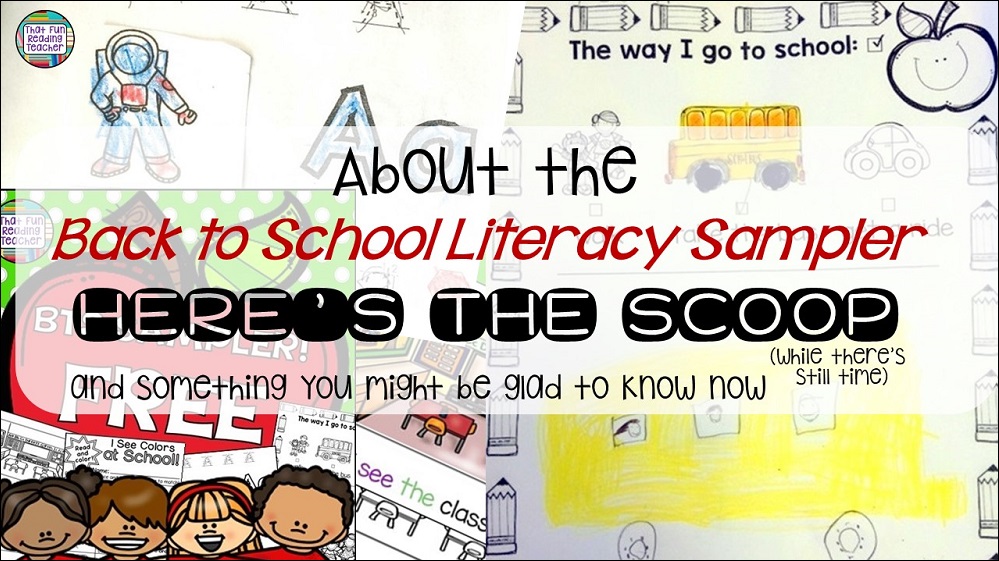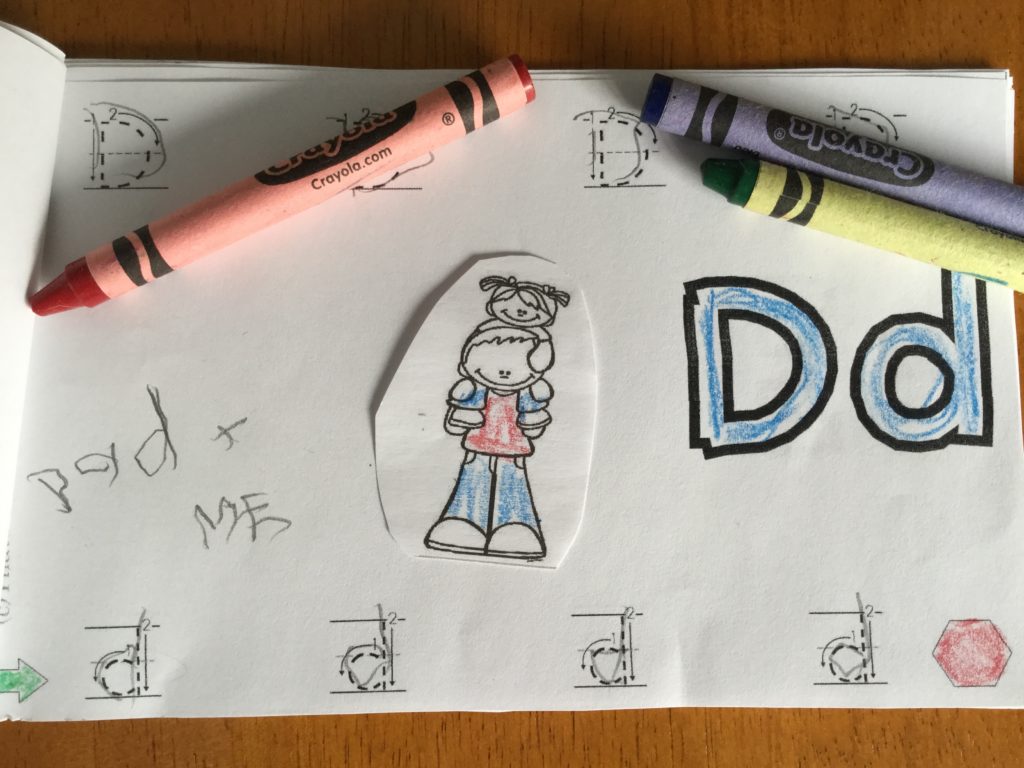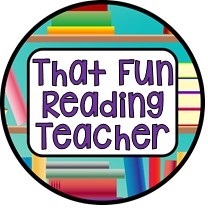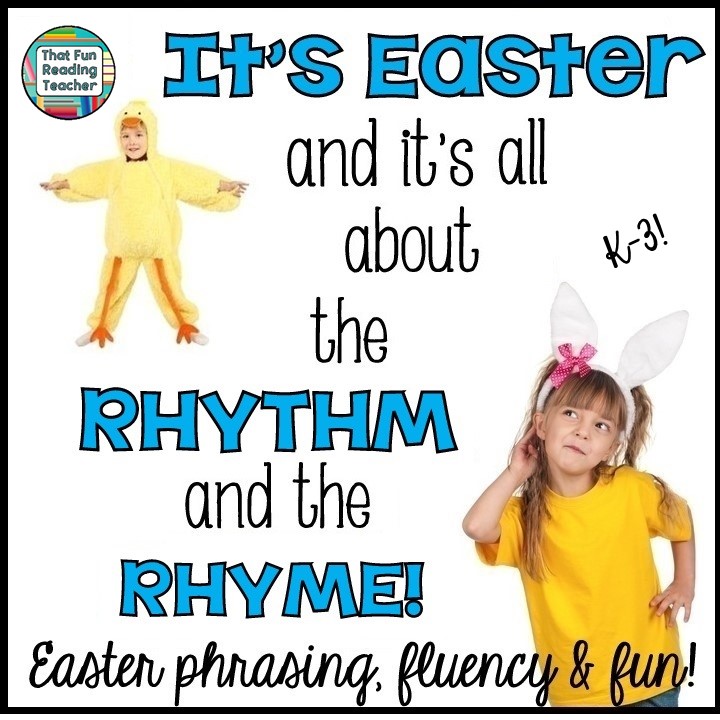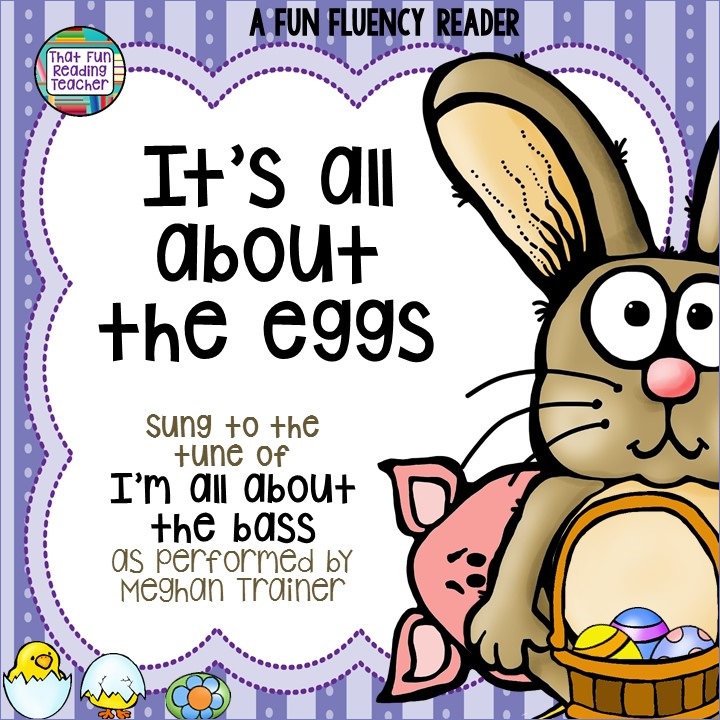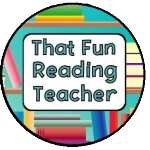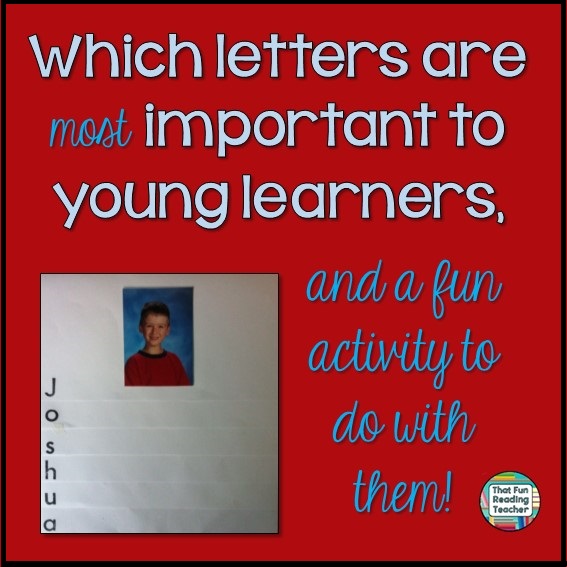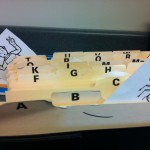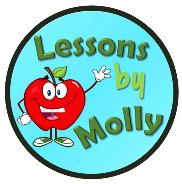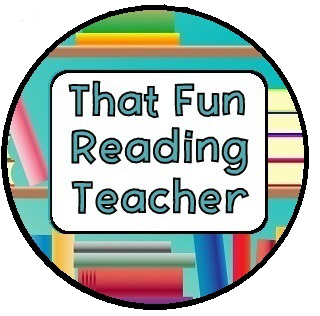Tag Archives : kindergarten
Language Arts Lesson – “Dolch Sight Word Fluency, The Bundle”
By Sue Kayobie
Pre-K – 1st Grade
This Bundle Include :
* 40 Pages Dolch Pre Primer
* 52 Pages Dolch Primer
* 41 Pages Dolch First Grade
Try the Freebie:)
Free Dolch Sight Word Fluency
Here are the individual products:)
Dolch Sight Word Fluency Pre-Primer
Dolch Sight Word Fluency Primer
Dolch Sight Word Fluency First Grade
Follow my TPT store for notifications, sale, and freebies.
Thank You!
Sue
Language Arts Lesson – “Alphabet Fine Motor Skills, The Bundle”
By Sue Kayobie
Pre-K – 1st Grade
This Bundle Include:
52 Pages of Alphabet Fine Motor Skills Set 1
26 Pages of Alphabet Fine Motor Skills Set 2
26 Pages of Alphabet Fine Motor Skills Set 3
Here are the individual products:
Alphabet Fine Motor Skills Set 1
Alphabet Fine Motor Skills Set 2
Alphabet Fine Motor Skills Set 3
If you like this product, you might also like these products below:
Alphabet Activities
Alphabet Recognize & Color
Alphabet Trace & ColorAlphabet Cut & PasteAlphabet Writing Practice
Follow my TPT store for notifications, sale, and freebies.
Thank You!
Sue
FREE LANGUAGE ARTS LESSON – “August Hand Writing Practice Book Freebies”
By Sue Kayobie
Kindergarten, 1st Grade
Inside you will find:
– 3 pages of Hand Writing Practice BW version.
– 3 pages of Hand Writing Practice color version.
In this pack, your early writer will learn how to trace the words, trace the whole sentence and they have to copy the sentence. It’s fun and perfect for your early writer. These activities work well for fluency practice, homework, and for assessment use.
August Hand Writing Practice Book Freebies
Here is the preview of this product.
Follow my TPT store for notifications, sale, and freebies.
Thank You!
Sue
FREE LANGUAGE ARTS LESSON – ” July Hand Writing Practice Book Freebies”
By Sue Kayobie
Kindergarten, 1st Grade
Inside you will find:
– 3 pages of Hand Writing Practice BW version.
– 3 pages of Hand Writing Practice color version.
In this pack, your early writer will learn how to trace the words, trace the whole sentence and they have to copy the sentence. It’s fun and perfect for your early writer. These activities work well for fluency practice, homework, and for assessment use.
July Hand Writing Practice Book Freebies
Here is the preview of this product.
Follow my TPT store for notifications, sale, and freebies.
Thank You!
Sue
FREE LANGUAGE ARTS LESSON – “CVC Matching Practice Free Samples”
By Sue Kayobie
Kindergarten, 1st Grade
This product includes color and BW (black and white) short vowel CVC Matching Practice. Your students will need to read the CVC words and match them with the right pictures. This is also great for your students that still need to work on their motor skills.
I hope this will be fun activities for your students as they learn CVC Words.
The CVC Words included in this pack are :
*Short A: ab, ad, ag, am, an, ap, ar, at, ax.
*Short E: eb, ed, eg, em, en, et.
*Short I: ib, id, ig, im, in, ip, it, ix.
*Short O: ob, od, og, om, op, ot, ox.
*Short U: ub, ud, ug, um,un, up, us, ut, ux.
CVC Matching Practice Free Samples
Here is the preview of the product.
Follow my TPT store for notifications, sale, and freebies.
Thank You!
Sue
FREE LANGUAGE ARTS LESSON – “CVC Short Vowel Easy & Fun Practice Free Samples”
By Sue Kayobie
Kindergarten, 1st Grade
This product includes color and BW (black and white) short vowel CVC Practice. Your students will need to read the CVC words, trace the words, and cut & paste the pictures into the matching CVC words.
I hope this will be fun activities for your students as they learn CVC Words.
The CVC Words included in this pack are :
*Short A: ab, ad, ag, am, an, ap, at, ax.
*Short E: eb, ed, eg, em, en, et.
*Short I: ib, id, ig, im, in, ip, it, ix.
*Short O: ob, od, og, om, op, ot, ox.
*Short U: ub, ud, ug, um,un, up, us, ut, ux.
CVC Short Vowel Easy & Fun Practice Free Samples
Here is the preview of the products.
Follow my TPT store for notifications, sale, and freebies.
Thank You!
Sue
FREE LANGUAGE ARTS LESSON- ” Free CVC Short Vowel Word Hunt”
By Sue Kayobie
Kindergarten, 1st Grade
This product includes 5 pages BW (black and white) short vowel CVC word hunt. Your students will need to read the CVC words list, find the CVC words in a crossword puzzle, highlight the CVC words, and color the short vowel CVC pictures.
I hope this will be fun activities for your students as they learn their CVC short vowel words.
Free CVC Short Vowel Word Hunt
Here is the preview of the product.
Follow my TPT store for notifications, sale, and freebies.
Thank You!
Sue
FREE LANGUAGE ARTS LESSON-“Free Samples Alphabet Fine Motor Skills Set 3”
Free Samples Alphabet Fine Motor Skills Set 3
by Sue Kayobie
Pre Kindergarten, Kindergarten
This 3 pages of Alphabet Fine Motor Skill Set 3 are perfect for preschool and kindergarteners working on fine motor skills!
Practice makes perfect, this set is a continuation of the previous sets. It will encourage your students to practice more on their handwriting, and they will have to trace the pictures.
These Alphabet Fine Motor Skill activities work well for independent work, literacy center ideas, fluency practice, homework, and for assessment use.
Free Samples Alphabet Fine Motor Skills Set 3
Go to my TPT store to get the full version product:
Alphabet Fine Motor Skills Set 3
This set is part of a bundle. Save some money with the bundle:
Alphabet Fine Motor Skills, The Bundle
Follow my store to get more freebies, notification, and sale.
Thanks!
Sue Kayobie
Connect with me:
FREE LANGUAGE ARTS LESSON-“Free Samples Alphabet Fine Motor Skills Set 2”
Free Samples Alphabet Fine Motor Skills Set 2
by Sue Kayobie
Pre Kindergarten, Kindergarten
This 3 pages of Alphabet Fine Motor Skill Set 2 are perfect for preschool and kindergarteners working on fine motor skills!
This set encourages students to focus on their alphabet handwriting, to start drawing a different type of lines – the first step in pencil control and enhances both motor planning and fine motor skills.
These Alphabet Fine Motor Skill activities work well for independent work, literacy center ideas, fluency practice, homework, and for assessment use.
Free Samples Alphabet Fine Motor Skills Set 2
Go to my TPT store to get the full version product:
Alphabet Fine Motor Skills Set 2
This set is part of a bundle. Save some money with the bundle:
Alphabet Fine Motor Skills, The Bundle
Follow my store to get more freebies, notification, and sale.
Thanks!
Sue Kayobie
Connect with me:
FREE LANGUAGE ARTS LESSON-“Free Samples Alphabet Fine Motor Skills Set 1”
Free Samples Alphabet Fine Motor Skills Set 1
by Sue Kayobie
Pre Kindergarten, Kindergarten
This 3 pages of Alphabet Fine Motor Skill Set 1are perfect for preschool and kindergarteners working on fine motor skills!
This set encourages students to trace the word, and trace the line to the matching picture. On this set, I also include the pages with and without tracing lines. You can choose which one that suits your students.
These Alphabet Fine Motor Skill activities work well for independent work, literacy center ideas, fluency practice, homework, and for assessment use.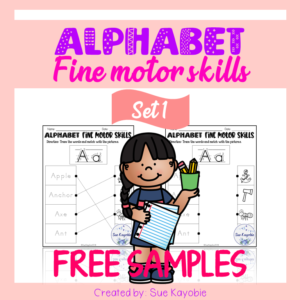
Free Samples Alphabet Fine Motor Skills Set 1
Go to my TPT store to get the full version product:
Alphabet Fine Motor Skills Set 1
This set is part of a bundle. Save some money with the bundle:
Alphabet Fine Motor Skills, The Bundle
Follow my store to get more freebies, notification, and sale.
Thanks!
Sue Kayobie
Connect with me:
FREE MATH LESSON-“Number 1 – 20 Writing Practice Set 2 Free Samples”
Number 1 – 20 Writing Practice Set 2 Free Samples
By Sue Kayobie
Pre Kindergarten, Kindergarten
This Writing Practice Set 2 is another product for your students who are struggling with their handwriting. It will teach your little learner to learn the first step of numbers. They will learn how to trace the number and the word number.
These Number 1 – 20 Writing Practice Set 2 work well for independent work, literacy center ideas, fluency practice, homework, and for assessment use.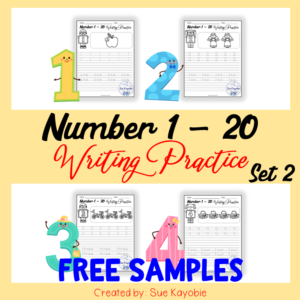
Number 1 – 20 Writing Practice Set 2 Free Samples
Go to my TPT store to get the full version product:
Number 1 – 20 Writing Practice set 2
Follow my store to get more freebies, notification, and sale.
Thanks!
Sue Kayobie
Connect with me:
FREE MATH LESSON-“Number 1 – 20 Count & Dab Free Samples”
Number 1 – 20 Count & Dab Free Samples
By Sue Kayobie
Pre Kindergarten, Kindergarten
This packet is designed to offer a fun, engaging and educational way to work on number recognition and counting skills during your school year.
This packet work well for independent work, literacy center ideas, fluency practice, homework, and for assessment use.
Number 1 – 20 Count & Dab Free Samples
Go to my TPT store to get the full version product:
Number 1 – 20 Count & Dab
This set is part of a bundle. Save some money with the bundle:
Number 1 – 20, The Bundle
Follow my store to get more freebies, notification, and sale.
Thanks!
Sue Kayobie
Connect with me:
FREE MATH LESSON-“Number 1 – 20 Find & Count Free Samples”
Number 1 – 20 Find & Count Free Samples
By Sue Kayobie
Pre Kindergarten, Kindergarten
This packet is designed to offer a fun, engaging and educational way to work on number recognition and counting skills during your school year. Your students will have to color the picture, find the pictures, count the pictures, trace and write the number.
This packet work well for independent work, literacy center ideas, fluency practice, homework, and for assessment use
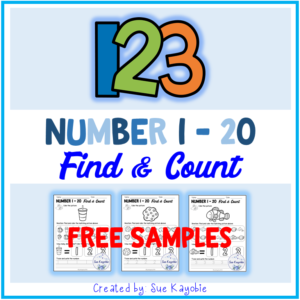 Number 1 – 20 Find & Count Free Samples
Number 1 – 20 Find & Count Free Samples
Go to my TPT store to get the full version product:
Number 1 – 20 Find & Count
This set is part of a bundle. Save some money with the bundle:
Number 1 – 20, The Bundle
Follow my store to get more freebies, notification, and sale.
Thanks!
Sue Kayobie
FREE MATH LESSON-“Number 1 – 20 Read & Trace Free Samples”
Number 1 – 20 Read & Trace Free Samples
by Sue Kayobie
Pre Kindergarten, Kindergarten
This packet is designed to offer a fun, engaging and educational way to work on number recognition and counting skills during your school year. Your students will have to read the number and trace the lines to the matching word number.
This packet work well for independent work, literacy center ideas, fluency practice, homework, and for assessment use.
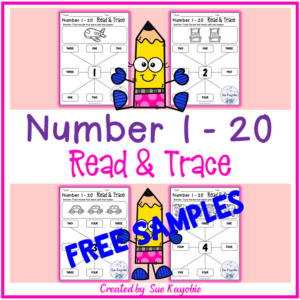 Number 1 – 20 Read & Trace Free Samples
Number 1 – 20 Read & Trace Free Samples
Go to my TPT store to get the full version product:
Number 1 – 20 Read & Trace
This set is part of a bundle. Save some money with the bundle:
Number 1 – 20, The Bundle
Follow my store to get more freebies, notification, and sale.
Thanks!
Sue Kayobie
FREE LANGUAGE ARTS LESSON – “June Reading Comprehension Activities Freebies”
June Reading Comprehension Activities Freebies
by Sue Kayobie
Kindergarten, 1st grade
Are you looking for monthly Reading Comprehension Activities for your Kindergarten students? Look no further, and these monthly passages are perfect for beginning readers.
This freebies set comes in three formats. 2 pages of Reading Fluency, 2 pages of Reading fluency check cut and paste, and 2 pages of Reading Comprehension will suit the needs of your students. I have provided a copy of all those pages without the “dots” for tracking. These activities work well for a small group practice, fluency practice, class discussions, homework, and for assessment use.
Go to my TPT store to get more free monthly Reading Comprehension Activities.
Thanks!
Sue Kayobie
FREE LANGUAGE ARTS LESSON – “July Reading Comprehension Activities Freebies”
July Reading Comprehension Activities Freebies
by Sue Kayobie
Kindergarten, 1st grade
Are you looking for monthly Reading Comprehension Activities for your Kindergarten students? Look no further, and these monthly passages are perfect for beginning readers.
This freebies set comes in three formats. 2 pages of Reading Fluency, 2 pages of Reading fluency check cut and paste, and 2 pages of Reading Comprehension will suit the needs of your students. I have provided a copy of all those pages without the “dots” for tracking. These activities work well for a small group practice, fluency practice, class discussions, homework, and for assessment use.
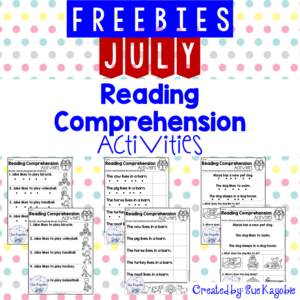
Go to my TPT store to get more free monthly Reading Comprehension Activities.
Thanks!
Sue Kayobie
Simple ways to help kids communicate their feelings!
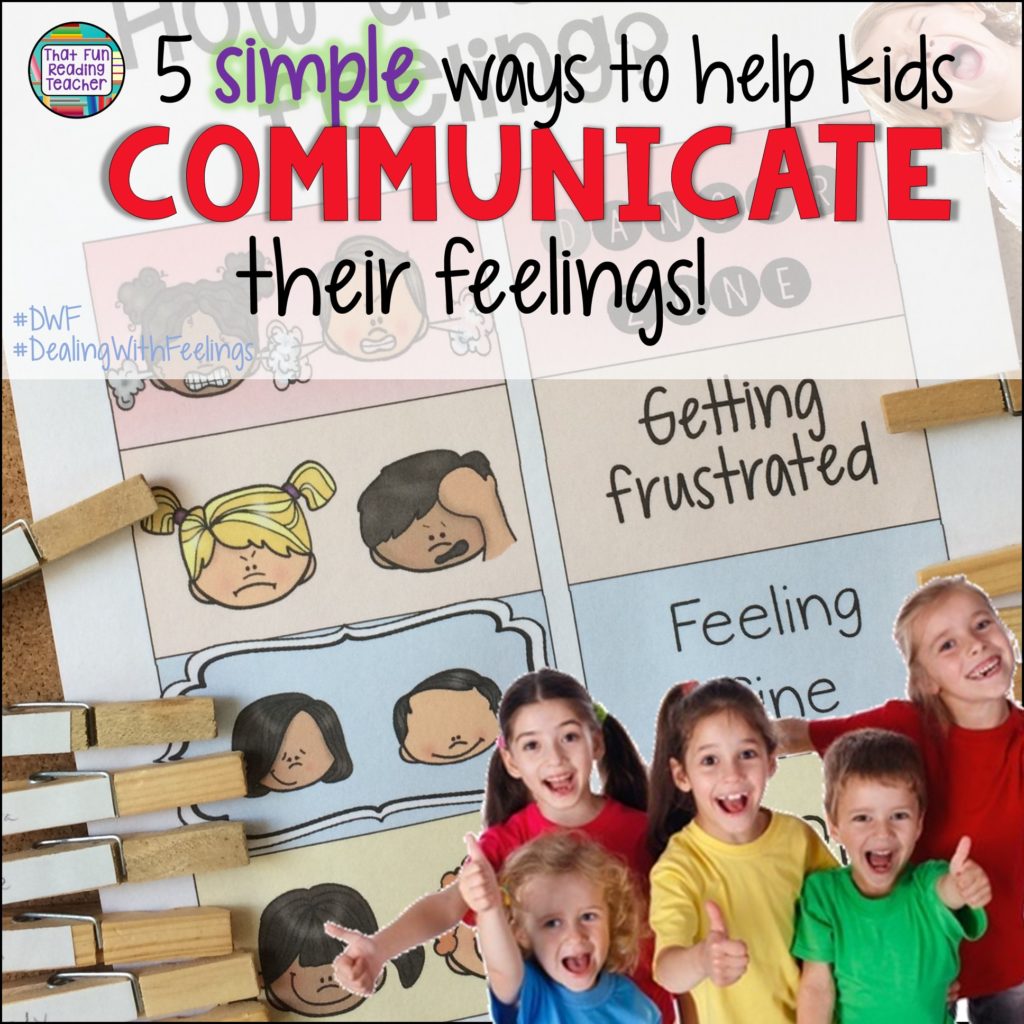
When kids are comfortable with communicating their feelings, they often end up communicating what they most deeply need. When their feelings are validated, the groundwork for self-regulation is being put into place. And so, fitting emotional literacy naturally into a child’s life early simply makes good sense.
Here are 5 simple ways to help kids communicate their feelings:
1. Communicate feelings yourself (and encourage role-models to do so, too)!
Kids do what we do. They observe and experience how the adults and role models in their lives identify, accept and manage their own feelings and the emotions of others, and use what they have processed as a basis for their own beliefs and practices.
Whenever we, the grown ups, can use language including “I feel, I felt, I remember feeling, etc.” we are making a deposit into the emotional language banks of the children in our presence.
Many people find discussing feelings and emotions difficult, and the toughest part can be starting the conversation. The good news is that the first conversations about feelings do not have to be personal!
2. Read stories!
Even in kindergarten, there are children who are already uncomfortable about discussing their own feelings. I have yet to meet a little person who is not willing to hear a story or watch something on YouTube!
I have been developing the Dealing With Feelings stories since 2013, and frequently use them on my iPad when needed, providing students with a line-art copy to color. The characters in these stories model emotional literacy on a level that kids can relate to.

Dealing With Feelings Stories: I simply say, “Would you like to hear a story?” and allow the child to discover connections to the character as we read.
(We all know how motivated we are to discuss something we’re uncomfortable with!) Listening to a story is often calming!
There are so many amazing feelings / emotions books available today, that I have a Pinterest board dedicated to them. Check it out:
Many of these stories are also read-aloud on YouTube!
3. Provide pictures showing feelings / expressions!
A child who wants to communicate his or her feelings but does not have the vocabulary to say how he or she feels, can point to a picture s/he relates best to.
Picture dictionaries often have a page dedicated to feelings, which can be bookmarked with a sticky note. Years ago, I made a feelings bulletin board with my firsties from photographs, newspaper and magazine clippings.
Having posters in the classroom is most effective when done appropriately for the group you have. Keeping it simple with fewer posters for younger children is recommended to avoid overwhelming the kids, while lining up multiple posters in older classes can be be especially useful to students who are writing about feelings.
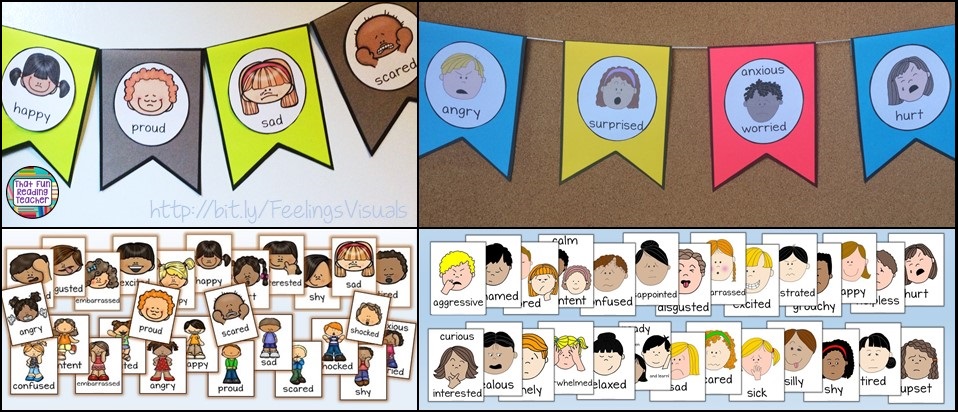
I like to display half-page feelings flags where kids can point to them. The posters shown at the bottom are 8 1/2 x 11 pages, and are also included as playing cards in my visuals, tools and activities set.
Earlier in my teaching career, I used feelings pictures for individual students on a ring, but have found that (like visual schedules) in recent years, increasing numbers of students benefit from them being posted right on the wall (and the rings are easily misplaced)!
4. Feelings scales
Feelings scales can be used for an entire class or for individuals. In the photo below, the kids’ names are on clothes pegs, and the feelings scale has been printed on thick card paper and laminated.
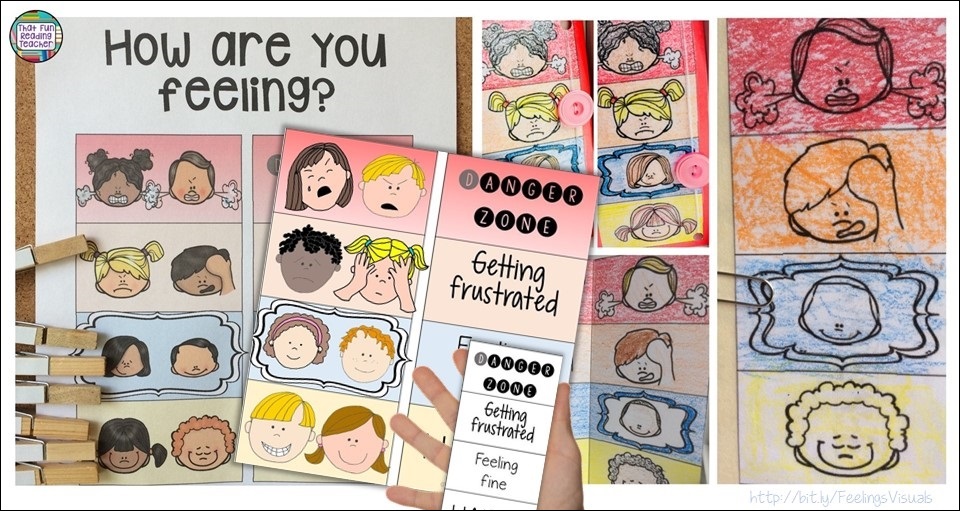
Feelings scales like these make it easier for kids to communicate their emotions without saying a word. Students can answer “How are you feeling?” by simply pointing to a picture, or with the slide of a paperclip, button or placement of a clothes peg. (The button slider pictured in the top middle doubles as a fidget toy!)
I’ve used feelings scales with individual students. They are especially helpful with kids whose frustration moves into raging anger quickly, and lose control. With a feelings scale, a child can make it clear to themselves, and others, when they are becoming frustrated, so that measures can be put in place to prevent further escalation.
5. Work ‘feelings talk’ into daily routines
- Have a star student? If that student is trying to share something with the class and is interrupted, how does it make him/her feel?
- Discussing the calendar, an upcoming holiday? How many people feel excited about it?
- Celebrating a child’s birthday? How does it feel to be the birthday child? Is it normal to feel jealous that it isn’t your own birthday?
- Getting close to outdoor time? Have an over-exaggerated, humorous gripe session about the most frustrating part of getting ready for home!
The items pictured in this post are a part of:
Follow me on Facebook for update news on this product!
Best wishes to all of you, your families and students!
Ida Mae
Related:
Visual Schedules in kindergarten and primary classrooms – the benefits!
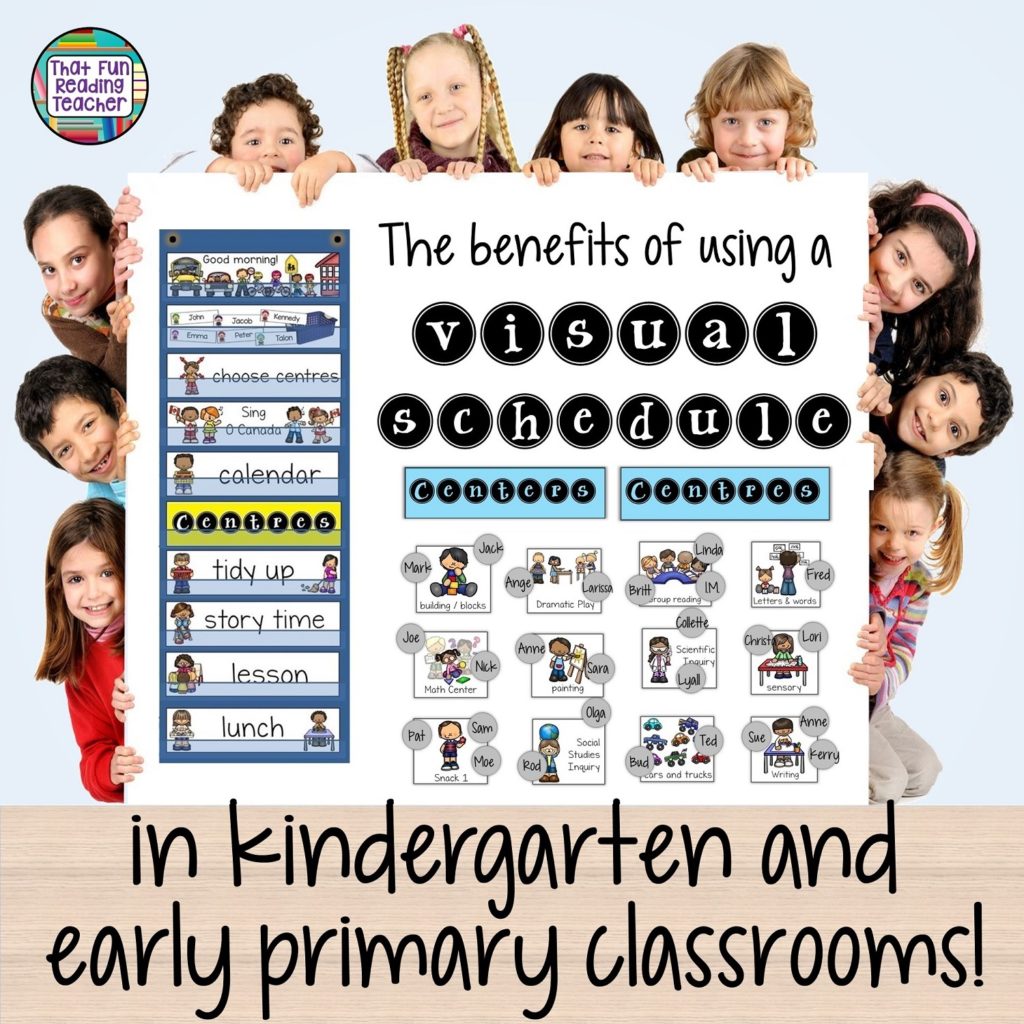
Photo credit: Copyright: <a href=’https://www.123rf.com/profile_luislouro’>luislouro / 123RF Stock Photo</a>
Do you use a visual schedule in your classroom? As a special education teacher working in many kindergarten and primary classes, I’ve seen how beneficial they are for the whole class!
The origin of visual schedules
In special education, we had been putting picture symbol schedules in place for our students with autism for years, as they provide
- an overview of the student’s day, in parts or as a whole, so the student has an idea of what to expect (this helps prevent anxiety)
- a means of communication for students who struggle with oral language and / or auditory processing (they can point at the pictures to help get their message across, follow the pictures to understand what they might have missed verbally)
- structure and increased independence, allowing students to manage transitions with less support
- the flexibility of making changes to only the necessary parts of the schedule without having to change the entire day.
- a sense of understanding how their day works, and counts down as blocks of time wrap up, helps kids feel a sense of accomplishment, more safe and in control of their emotions
The shift to whole class schedules
Our consultants began recommending visual schedules for more groups of students as time went on – students struggling with anxiety, managing behavior, transitions. I began to notice that a few classroom teachers had just stopped using the individual student schedules (too cumbersome with multiple students with schedules in the class) and gone to a classroom one instead – and the effect was amazing.
Students checked in on that schedule all day. As time passed, a card was moved or taken down. If plans changed, the teacher simply switched out the card, and the kids understood and accepted it. The morning schedule was discussed at the carpet in the morning, and the process repeated in the afternoon.
Why it’s becoming the new normal
How many times have you heard this lately?
Kindergarten is a social communication program.
Do you agree? My very first class was a kindergarten class, in 1996, and the catch phrase at that time was ‘We’re teaching them how to play the game of school’.
There are so many children in our classes now that struggle with social-communication, anxiety, self-regulation, learning disabilities, being in an overcrowded classroom, among other things. And teachers have more to manage than ever before.
Consider that:
- students regularly referring to the schedule throughout the day are prepared for transitions and managing themselves with greater independence
- the visual schedule takes on the role of a ‘first-then’ board, as students are able to see things they are looking forward to coming up (for example, homesick students can see blocks of time disappearing as it gets closer to home time; students who dislike pencil / paper tasks can look forward to recess etc.)
- students take pride in showing a visitor to the class that he or she can read, and knows what’s happening next
- it is easy for a substitute teacher to step in with an already established structure in place (and it can be left prepared for the next day without having to write an explanation!)
- With my Reading Recovery background, I can’t help but love the fact that this is just another way to drive home ‘reading the pictures’ for meaning first!
- it can be used as a tool for teaching ‘time’ (some teachers add clocks beside each item) and sequencing events in order
- The visual schedule makes a nice link to learning centres / centres
Have you tried using a visual schedule in your classroom? How has it been going for you?
Best wishes with your littles,
Ida Mae
If you are looking for a visual schedule and center / centre cards set, please check out mine below. The cards fit nicely into a pocket chart, can be used with adhesive magnets on the back, or simply pinned to a bulletin board. I’ve included months, days and Troll-themed editable name cards as well. Click the image to take you to my store to see the preview!
Are there cards you would like to see added to the schedule?
If so, please click the ‘ask a question’ tab in my TpT store, or email me at thatfunreadingteacher@gmail.com to suggest it for an update!
Related:
Free Back to School Literacy Lessons K-2
Hello my friends! Have you started to think about Back to School yet? (Has anyone ever really stopped?)
It’s an exciting time of year, and I always find it easier to sleep when I at least have the first few days planned out – and that involves getting to know my students. I like to find out who they are as people, how they feel about various aspects of school, get a glimpse of their skills, and most importantly – know how they’ll be getting home from school!
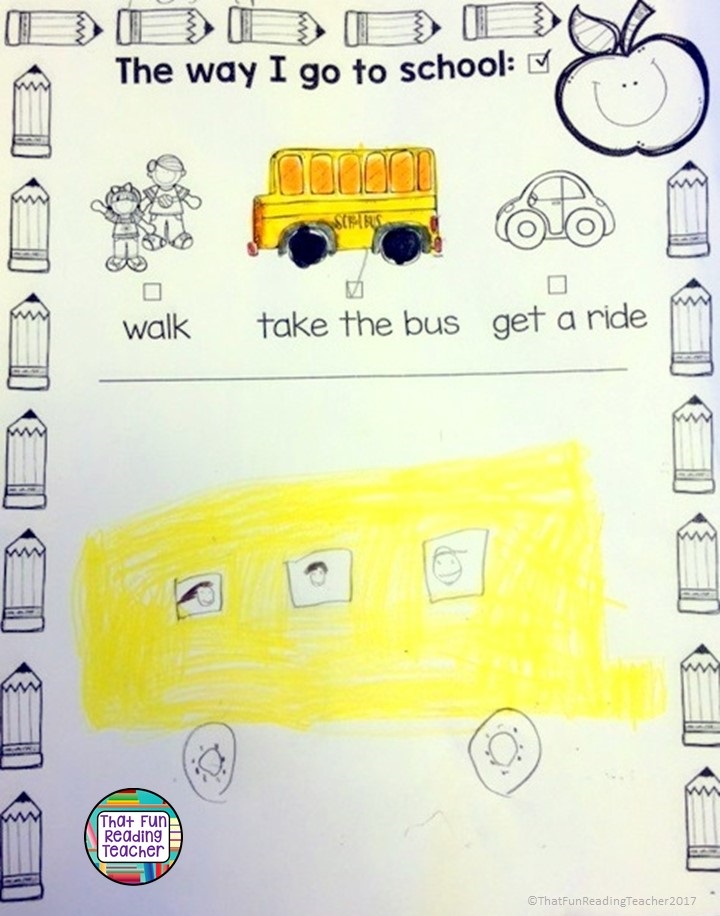
Disclaimer: This activity is by no means a guaranteed method of validating a child’s transportation arrangements for one day or the entire school year, but does make a nice introduction to a graphing activity.
I wanted to share this ten page Back to School literacy sampler with you, so you will have a window into some of the products I use with my K-2 students at the beginning of the year.
What else is in the BTS sampler?
I do not want to ruin the surprise, but I will tell you that this sampler could lead you to more free samples…especially if you like Sight-Word PreEmergent (Level aa) or Emergent (Level A and B) readers with sentence puzzles and fun follow ups.
Ok, getting carried away now. Almost told you about the crazy fun game I’m making. But I didn’t!
I will leave you with this thought, however. Start collecting smart phone boxes.
Enjoy summer for as long as you can!
Take care,
Ida Mae, aka
End of year lesson: Writing for real purposes in the summer!
Empower and motivate beginning readers by showing them they can already read!
LANGUAGE ARTS IDEAS – Fun Easter phrasing and fluency activities!
Easter is a great time to have fun with phrasing and fluency with early readers. Grab your bunny ears and check these out!
Use poetry, music and movement!
Remember the Hokey-Pokey song? Years ago I rewrote it into The Bunny Hop for my Kindergarten students. It works particularly well if modeled and students are given the opportunity to echo it back the first few times before giving them a paper with the text (to color – you’ve got to do the actions!):
(Black and white version included with it – ideal for poetry folders!)
Certain phrases just belong together, don’t they? All about the seems to be one such phrase.
When Meghan Trainor was singing I’m All About the Bass every time I turned on the radio in 2014, there was no getting it out of my head. This Fun, Fluency Reader version practically wrote itself as I drove in to school listening to Trainor’s voice every day.
My students knew the tune instantly. I modeled the first read to them, and we practiced a few phrases in isolation before it was fluent and perhaps a little too fun…
There is a twist on a familiar Fairy Tale in this book that made the kids laugh (but humor is a topic for another day…).
Limitation of liability: It’s all about the Eggs is not recommended for those who are prone to getting songs stuck in their head or with one last nerve.
Encourage oral language beyond one word.
Encourage kids to speak in sentences and phrases by asking questions and modeling answers. Kids mimic the adults in their lives (cringe – I’ve heard my own phrases from the mouths of babes a few too many times, have you?). When hunting for an Easter Egg, asking ‘Where is it?’ may elicit a reply of ‘there’ from a little one, but an adult can follow with the modeling of a phrase or phrases, for example: “Oh, yes, it’s under the chair’ for a gentle teachable moment.
While teaching special education to a student with prepositional language goals on an IEP, one of my students did have Easter egg hunts in my resource room to ‘practice’ for Easter.
What are some of your favorite phrasing and fluency boosters?
Rethinking Reading Logs for young readers
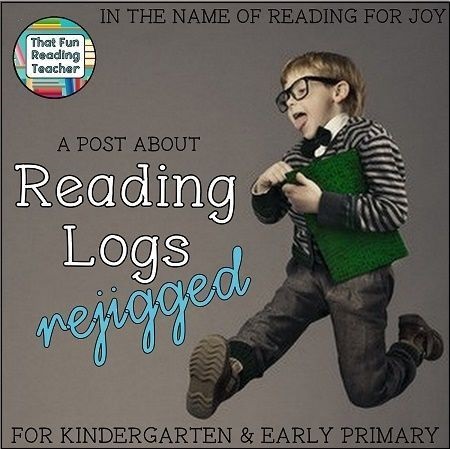
I have spent most of my career teaching little people, and a good part of that time parenting little people, too. One topic of great discussion (well beyond kindergarten and grade one) was that of the Reading Log.
As a first grade teacher, I had mixed feelings about sending them home. It’s fairly easy to figure out early on what will become of one’s students’ reading logs throughout the year. As parents, we all have the best intentions. Teachers know that. Many of us fill both roles.
Life gets busy, especially that in-between school and bed time when you have to make and clean up dinner between driving kids everywhere ensure they’re somewhat clean, and maybe even do some homework. I believe that most parents do read with, or to, their kids. Writing it down (especially when we’re exhausted and feeling like we’re being policed?) Well, that’s a whole other story.
How many evenings did I spend at the end of each month, sitting at my kitchen table with a selection of different colored pens, filling in my kids’ reading logs? We absolutely read each night, probably for too long, but we sure didn’t break the spell to keep track of it all!
It is because I valued passing on the love of reading that, in the case of traditional Reading Logs, our kids learned from me that I was okay with dishonesty (under very specific circumstances). Yep, they learned that the magic of reading trumped honesty. GULP.
The Parent / Teacher Connection:
When I was teaching Reading Recovery, between my training and the variety of students I had, I began to really understand the difference between passive and active learners, and the connection between our roles as parents and teachers. Have you heard the phrase ‘Never do for a child what he can do for himself’? I’m a believer.
There was a very definite link between how quickly my students that were more independent with getting ready for recess or home, for example, and using the strategies I was teaching them, were progressing through the program. Those who simply shrugged when I asked them a question, or stood daydreaming in the hall, expecting someone to come and zip up their jackets were the ones who seemed to struggle the most. They were also the ones who left their reading bags at home, waited to be directed for every step of the same structured lesson we had each day. Some of my students did not have bedtime stories because they ‘didn’t have time’. (That did not surprise me with the amount of time it took to travel down a short hallway!)
I have ‘rejigged’ the reading log for the little people, with the purpose of parents and teachers focusing on maintaining the natural enthusiasm and building responsibility for their learning in our little people! Have a look:
 |
This is the front cover, with space for the student’s portrait and name. Copy onto colored paper or let them color it themselves! |
 |
This is the first inside page of the Reading Log, with the legend and a note for parents explaining how it all works! |
 |
Students draw in & submit reading log with a page completed monthly. after discussing the 3 boxes at bottom at home. |
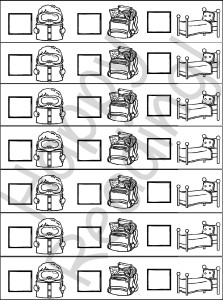 |
This is a later addition to Reading Logs – rejigged, for anyone wishing to add extra strips for additional tracking (weekly?) Simply return to your My Purchases page & download an update! |
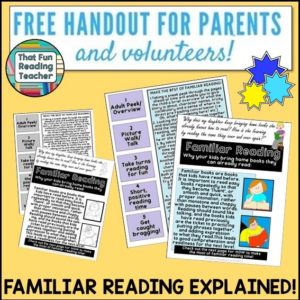 |
While this is not part of Reading Logs – rejigged it is the ideal info sheet (& freebie) to include with it or in your familiar reading bags! |
It is my hope, that by focusing on each child as an individual ‘Superstar’ Reader (front cover), who has an important job to do in bringing his or her special Reading Folder or bag home regularly (hopefully with a library book to listen to, and/or some familiar reading), and returning it to school, it help foster a sense of pride in being a big kid who ‘reads’.
It is also my hope that our earliest little readers and their parents find reading stories at bedtime something they look forward to each night, and that stories accompany them elsewhere in their lives!
Below, please find the links to the free one month trial version and the full versions of Reading Logs – rejigged! If you like this idea, please pass it on!
I would love to hear your thoughts on reading logs, this new one, and alternatives you use.
Best wishes to all of you as we embark on another school year!
 FULL PRODUCT |
 FREE SAMPLE FREE SAMPLE |
The full product comes with all 12 months, plus additional months for August, October,
November, December and April to keep options open regardless of country or religion!

Related:
Follow That Fun Reading Teacher’s board Kindergarten Literacy Fun on Pinterest.
http://thatfunreadingteacher.com/
ThatFunReadingTeacher@gmail.com
Click the symbol above to access my TpT Store! 😉
Reading Logs for young readers? Here’s an alternative!

I have spent most of my career teaching little people, and a good part of that time parenting little people, too. One topic of great discussion (well beyond kindergarten and grade one) was that of the Reading Log.
As a first grade teacher, I had mixed feelings about sending them home. It’s fairly easy to figure out early on what will become of one’s students’ reading logs throughout the year. As parents, we all have the best intentions. Teachers know that. Many of us fill both roles.
Life gets busy, especially that in-between school and bed time when you have to make and clean up dinner between driving kids everywhere ensure they’re somewhat clean, and maybe even do some homework. I believe that most parents do read with, or to, their kids. Writing it down (especially when we’re exhausted and feeling like we’re being policed?) Well, that’s a whole other story.
How many evenings did I spend at the end of each month, sitting at my kitchen table with a selection of different colored pens, filling in my kids’ reading logs? We absolutely read each night, probably for too long, but we sure didn’t break the spell to keep track of it all!
It is because I valued passing on the love of reading that, in the case of traditional Reading Logs, our kids learned from me that I was okay with dishonesty (under very specific circumstances). Yep, they learned that the magic of reading trumped honesty. GULP.
The Parent / Teacher Connection:
When I was teaching Reading Recovery, between my training and the variety of students I had, I began to really understand the difference between passive and active learners, and the connection between our roles as parents and teachers. Have you heard the phrase ‘Never do for a child what he can do for himself’? I’m a believer.
There was a very definite link between how quickly my students that were more independent with getting ready for recess or home, for example, and using the strategies I was teaching them, were progressing through the program. Those who simply shrugged when I asked them a question, or stood daydreaming in the hall, expecting someone to come and zip up their jackets were the ones who seemed to struggle the most. They were also the ones who left their reading bags at home, waited to be directed for every step of the same structured lesson we had each day. Some of my students did not have bedtime stories because they ‘didn’t have time’. (That did not surprise me with the amount of time it took to travel down a short hallway!)
I have ‘rejigged’ the reading log for the little people, with the purpose of parents and teachers focusing on maintaining the natural enthusiasm and building responsibility for their learning in our little people! Have a look:
 |
This is the front cover, with space for the student’s portrait and name. Copy onto colored paper or let them color it themselves! |
 |
This is the first inside page of the Reading Log, with the legend and a note for parents explaining how it all works! |
 |
Students draw in & submit reading log with a page completed monthly. after discussing the 3 boxes at bottom at home. |
 |
This is a later addition to Reading Logs – rejigged, for anyone wishing to add extra strips for additional tracking (weekly?) Simply return to your My Purchases page & download an update! |
 |
While this is not part of Reading Logs – rejigged it is the ideal info sheet (& freebie) to include with it or in your familiar reading bags! |
It is my hope, that by focusing on each child as an individual ‘Superstar’ Reader (front cover), who has an important job to do in bringing his or her special Reading Folder or bag home regularly (hopefully with a library book to listen to, and/or some familiar reading), and returning it to school, it help foster a sense of pride in being a big kid who ‘reads’.
It is also my hope that our earliest little readers and their parents find reading stories at bedtime something they look forward to each night, and that stories accompany them elsewhere in their lives!
Below, please find the links to the free one month trial version and the full versions of Reading Logs – rejigged! If you like this idea, please pass it on!
I would love to hear your thoughts on reading logs, this new one, and alternatives you use.
Best wishes to all of you as we embark on another school year!
 FULL PRODUCT |
 FREE SAMPLE FREE SAMPLE |
The full product comes with all 12 months, plus additional months for August, October,
November, December and April to keep options open regardless of country or religion!

Related:
Follow That Fun Reading Teacher’s board Kindergarten Literacy Fun on Pinterest.
http://thatfunreadingteacher.com/
ThatFunReadingTeacher@gmail.com
Click the symbol above to access my TpT Store! 😉
Which letters are most important to young learners, and a fun (and FREE) activity!
If you want to get children’s interest, ask about their world.It really does revolve around them! The letters young kids learn to identify first are those that they see most often. Many of these are the letters in their names.There are a number of benefits beginning letter learning with letters a child is most familiar with.
Children learn best when they are happily engaged in what they are doing and are most enthusiastic when they feel confident.
With that in mind, here is the ‘how-to’ on the preparation and lesson for the ‘Letters in your name’ flipbook:
Preparation:
- Using 8 ½ x 14 paper, prepare the blank flip books. If a child has six letters in his name, you will need three sheets of paper to lay one on top of the other, leaving approximately two centimeters, or just under an inch between the bottoms of each piece of paper. When you fold the three papers in half, you will have six layers (see photo). Staple these pages together, covering any sharp staple ends safely. You now have the template for the ‘Letters in your name’ flipbook! Be sure to adjust for the length of each child’s name.
- Usually the children associate themselves with the first letter of their name. Consider whether or not you would like a photo to be used on the front cover so it can be ready for the activity, or provide people shaped tracers or stamps, and students can personalize from there
- Have a variety of options available to the children for illustrating the pages in their book. As noted in The benefits of a personal alphabet book, it is important to find out what the child naturally associates with each letter sound on her own. Reading Recovery teachers are equipped with a collection similar to the index car box in the photo, which allows for a quickly accessible variety of pictures for every letter. If what the child suggests is not available, it can simply be drawn. Many sticker collections can provide great content for these files as well as photocopies and pictures from fliers. Holiday fliers are particularly useful. ‘Witch’ and ‘ghost’ are popular alphabet book flier additions, thanks to Party Packagers and their terrific advertisements!
Materials for the activity:
- Upper case and lower case letter stamps (optional, but helpful)
- Prepared flip books (with child’s name lightly marked in pencil on the back)
- Glue sticks and coloring materials
- Small group setting (best done as a center)
- Scissors if using fliers that have not been cut
- Pictures for pages of flip books
The Activity:
- Introduce the activity by talking about names, how special they are, and reinforce that individuality and uniqueness are positive traits.
- Talk about the importance of the first letter of a name. Make big emphasis on capitalization here.
- Show the kids a model of the ‘Letters in your name’ flip book and ask them if they notice anything different about the first letter.
- If you are using stamps, show them the two sets. Explain how to use them, and about the difference between the upper and lower-case set.
- Explain that just like every person is different and special, everyone’s name book will also be different. Even if two children have the same name, it is important for them to choose a picture that jumps into their own mind right away when they hear a letter sound.
- Aim for two or three letters per day with each child. Say the letter sounds for the kids and ask them what comes into their mind when they hear them. If nothing, then leave that letter and move on. It is okay to leave a page blank. This is the start of a record of the child’s letter learning.
- Allow the children to make their pages special with colour and décor.
- Once the class is finished with this activity, send it home to be shared, but only after the information is transferred into a more permanent alphabet book that the child will continue to work on at school. This alphabet book will be a reference for the entire school year, and perhaps the next one, too.
- Have the children ‘read’ their ‘Letters in your name’ flipbook to others with pride. Reading buddies, volunteers, family members etc.
- Most importantly have fun!
What are some ways you introduce letter learning to kids?
Related:
Best wishes with Back to School, everyone!
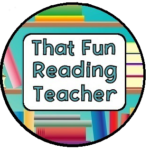 |
|
Free Language Arts Lesson “Clip Cards and a Gift Card”
It’s “Back to School” season and I have a few goodies for you! I’m excited to let you know that I am hosting a giveaway! Teachers Pay Teachers issued a gift card to me so that I could promote my store. Thank you TpT!
One lucky contestant will win a $10.00 gift card good toward teaching resources (or clip art) at the Teachers Pay Teachers website.
There’s only one requirement on the Rafflecopter to enter the contest. A second task can be done to increase your odds of winning. You’ll need to hurry! The contest ends on August 23, 2016! Although the contest will be short-lived, Teachers Pay Teachers gift cards NEVER EXPIRE! They may not be used with purchase orders.
Click the image shown below to visit my blog and enter the Rafflecopter contest! If you’re a kindergarten or first grade teacher, you will like the second goodie. It’s a complete set of FREE alphabet clip cards. If you’ve never used clip cards as a center activity, I highly recommend them. They’re easy to put together and provide hours of learning engagement. You’ll need a package of clothespins and some bright colored cardstock paper. This file prints with black ink.
If you’re a kindergarten or first grade teacher, you will like the second goodie. It’s a complete set of FREE alphabet clip cards. If you’ve never used clip cards as a center activity, I highly recommend them. They’re easy to put together and provide hours of learning engagement. You’ll need a package of clothespins and some bright colored cardstock paper. This file prints with black ink. 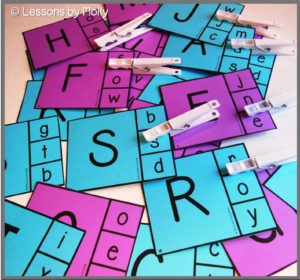 Children match the uppercase letters with the appropriate lowercase letters by “clipping” the clothespins to the appropriate answers. It’s best to program the answers on the backs of the cards with a highlighter or circular stickers. This way, the center becomes self-checking.
Children match the uppercase letters with the appropriate lowercase letters by “clipping” the clothespins to the appropriate answers. It’s best to program the answers on the backs of the cards with a highlighter or circular stickers. This way, the center becomes self-checking. 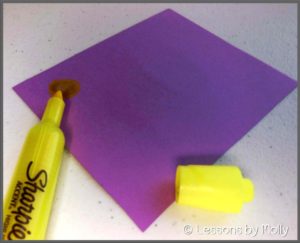 Letter knowledge is a kindergarten skill. However, there are many first graders that require additional practice . . . especially at the beginning of the school year when they are recovering from the “Summer Slump”. Additionally, many children enter first grade feeling frustrated and overwhelmed by their new grade level requirements. Providing struggling first graders with a center that they can complete at 96% to 100% accuracy builds their confidence in working independently.
Letter knowledge is a kindergarten skill. However, there are many first graders that require additional practice . . . especially at the beginning of the school year when they are recovering from the “Summer Slump”. Additionally, many children enter first grade feeling frustrated and overwhelmed by their new grade level requirements. Providing struggling first graders with a center that they can complete at 96% to 100% accuracy builds their confidence in working independently. 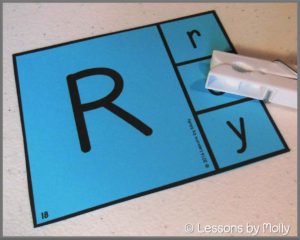 Click on the image shown below to get the alphabet center freebie!
Click on the image shown below to get the alphabet center freebie!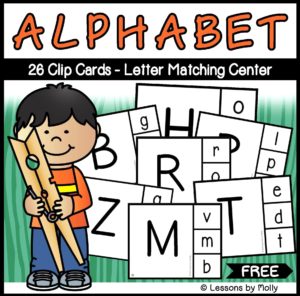 That’s all for now.
That’s all for now.
Copyright 2016 Lessons by Molly
Benefits of a personal alphabet book – a lesson from my Reading Recovery days
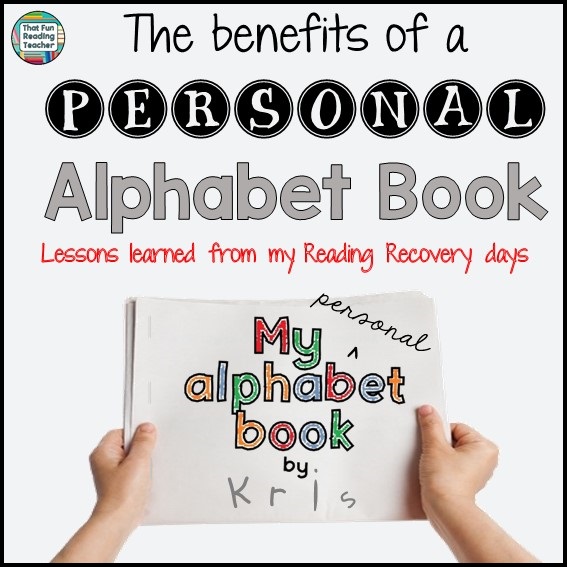
Why go to the trouble of creating a personal Alphabet Book for your students, instead of having everyone in the class work through each letter together? It sounds like a lot to manage, but creating links to a child’s life early in literacy learning is worth the confidence and gains they make later.
When I taught Reading Recovery to grade one students early in the school year, creating a personal alphabet book was one of the first things we did together when we started lessons. It wasn’t until seven years in to my teaching career that I understood the benefits of a personal alphabet book, and I have Dr. Marie Clay and my Reading Recovery teacher leaders to thank for that.
In Literacy Lessons Part Two, Dr. Clay explains:
The alphabet book is merely a record of what is known with spaces for what is ‘yet to be learned’ That gives the child a sense of the size of the task and a feeling of control over his own progress. It also provides a location to return to when a troublesome letter, still being confused, turns up. (p37)
She explains that children do not generally learn to identify letters by name or sound in alphabetical order and that identifying a letter by name or sound is equally useful for a child early on, as it is most effective to teach both name and sound together.
When children have one word for each letter that he or she knows for sure makes that letter sound, they use it as an anchor, a concrete example to hold all other words against for comparison.
When they have their own sound alphabet that they have created from the words most meaningful to them, the words that pop into their minds with the initial letter sounds and that association gives them confidence that they know that particular sound. It gives them the confidence to ‘spit’ that sound out when they see an unknown word on a page when they are reading, or put down that first letter when attempting to write a word they have never attempted before.
The personal alphabet book is the ultimate, at-a-glance reference guide. It is meaningful to each child, because that child constructed it from people and things that are meaningful to them already. The connections are already in place.
The key to the effectiveness of a personalized alphabet book is in its construction. It must be done slowly but with enthusiasm, following the child’s lead, reviewed often and used as reference.
Years ago, we spent hours cutting up old coloring books and worksheets to use as images for our students’ alphabet books. This led to the creation of a kit as a time-saver! Try it free in the BTS Sampler, linked below!
Ready to create a personal alphabet book? Here’s how.
Related:
 |
 |
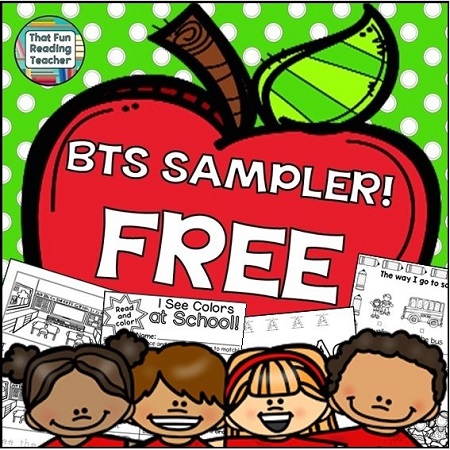 |
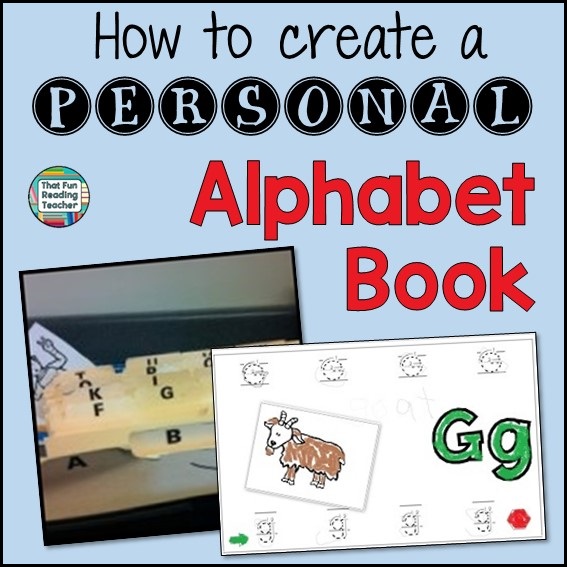 |
Best wishes for Back to School, everyone!
I.M. That Fun Reading Teacher!
 |
Starting a Reading Buddies program in your classroom? Some tips and a freebie!
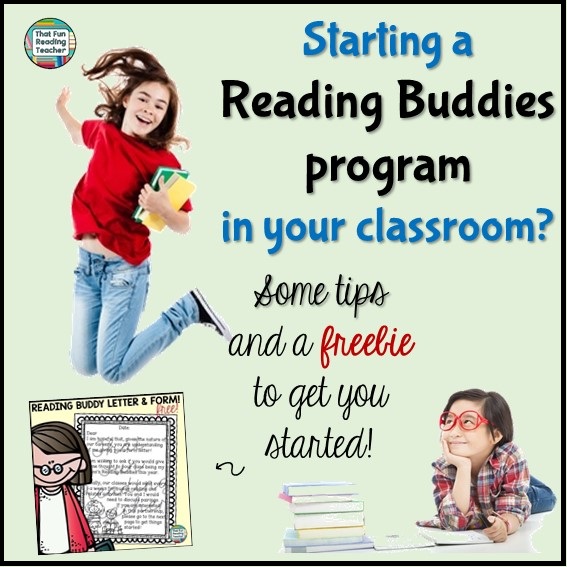
Thinking about starting a Reading Buddies program in your classroom this year? Here are some tips and tools to get things rolling!
Consider putting School-wide Reading Buddies on a staff meeting agenda.
Discuss the benefits for all students with your divisional leads and administration, and even if the seed of the idea is planted to be reassessed next year, it will give you a sense of who might be open to a pairing for this year.
Take age into consideration.
An age / grade difference of 2-3 years between buddies puts a clear boundary between who the big buddies and little buddies are.
Approach a colleague about pairing classes…
…and be realistic about whether your schedules will work! Casual conversation over lunch can often accomplish this, but it seems like our time is less our own these days! I have created this free letter and form to simplify the process:
Build Reading Buddy time into your timetable.
When ‘it’s official’ everyone knows what to expect, when. Perhaps it is alternate week familiar reading, word-work, or math skills review through games, part of character education or religious education for forty minutes. While may Reading Buddies may not appear in on the timetable your principal has to hand in to the school board, it’s important that the kids have this special time to look forward to. It could even happen over lunch!
Define expectations to both classes.
This is accomplished best if done as individual classes, as the expectations differ for the age groups in some ways. Review general expectations when they are brought together for the first few times, and provide visual reminders. Reading Buddies time can quickly look like recess if sixty kids are unsure of what the rules are, half the kids, ‘read the book already’ and have decided to hang out with someone else!
Talk to your partner class’ teacher about general and specific expectations.
I wrote general expectations in a storybook lesson format for my students, explaining to the bigger buddies (third graders) ‘This is what I am reading to your little buddies‘ (kindergarters). One of my valued TpT customers reads her class the story, then posts the pages on a bulletin board! I love that!
Here are some ideas for general expectations from my Reading Buddies Starter pack:
What are some expectations that you find important to put in place during Reading Buddies time?
Best wishes to all you!
I.M. at
Related:
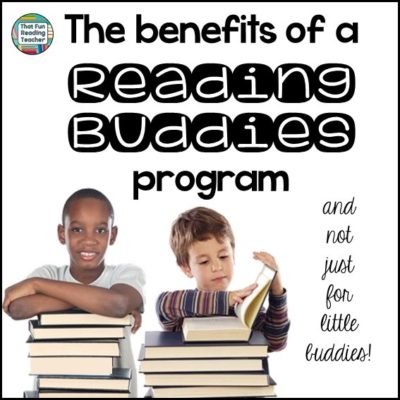 |
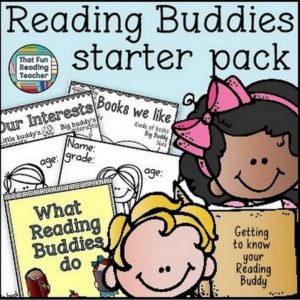 |
 |
 |
Back to School – Number Counting Posters
It might be “Christmas in July” but it’s “BACK TO SCHOOL” in August! Here’s a photo of my boxwood bushes done up with lights during the past holiday season.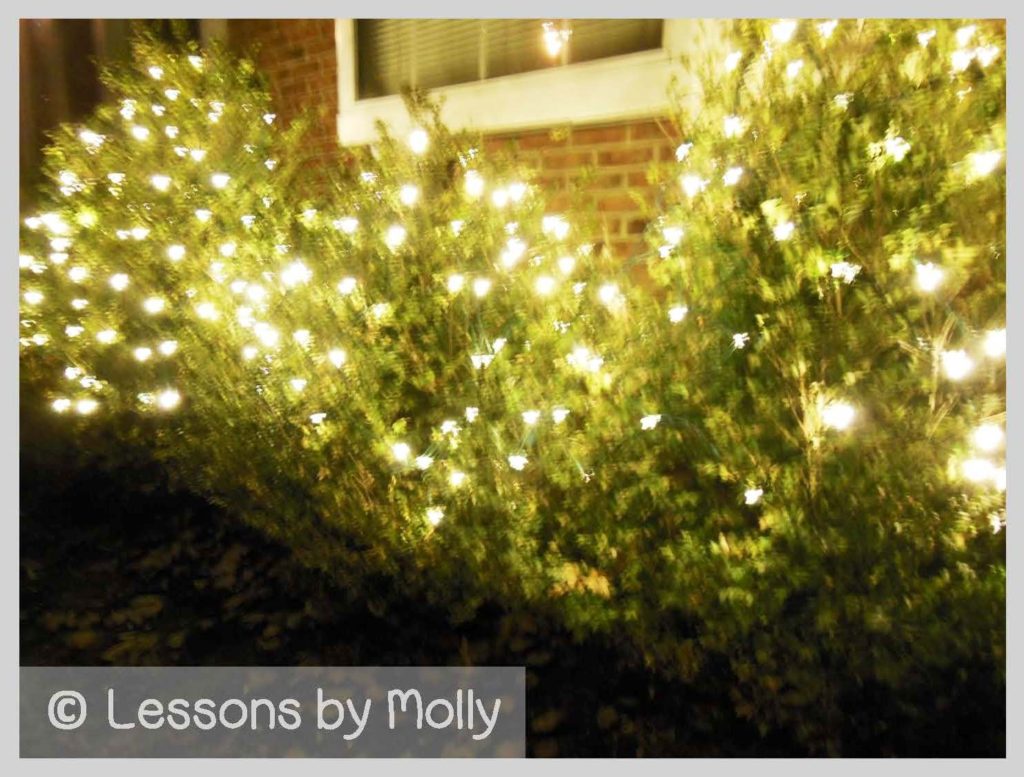 Well, it’s not Christmas yet but I do have a FREEBIE for you. Read on.
Well, it’s not Christmas yet but I do have a FREEBIE for you. Read on.
I’ve just finished a GIANT file of numeral and number counting posters. The posters have mosaic backgrounds. I purchased these papers from Bev’s Learning Hut and I couldn’t be more pleased with how beautiful they turned out! Best of all, mosaic designs have been in existence for a long time and they NEVER go out of style!
There are a total of SEVEN sets of colors in the priced file. I’m offering one set as a FREEBIE. (Merry Christmas in July!) The colors included in the larger file are red, blue, green, pink, orange, purple, and light blue. You’re getting the red set with blue fish!
Each set of posters includes numerals zero through twenty. There are colorful fish displayed on the posters to match each numeral shown. The children can practice counting skills by counting the fish on any given poster. If you display the posters at the children’s eye level on your classroom wall, they can practice counting during their spare time.
Each numeral is approximately 7 centimeters tall. The numeral font that I used is a ideal for modeling correct numeral formation. The numeral “4” is formed with straight lines. The line on the numeral “9” is straight so that is does not appear like an upside down “6”.
I have created these poster with simplicity in mind so that educators can use them to focus on a few of the related Common Core Math Standards for kindergarten. Those are:
1. Writing numerals 0 to 20.
2. Reading numbers 0 to 20.
3. Counting up to 20 objects (with numbers 0 to 10 in scattered formation) and naming the corresponding number.
You will need colored ink to print the posters. I recommend printing them with white cardstock paper. If you’d like, laminate them for long lasting use.
The slide show below shows some of the posters from the large file. You might notice that I was able to print without a white edge around my pages. The mosaic backgrounds are very attractive when there is NO WHITE BORDER. Plus, printing without the white edge means that you won’t spend any time trimming. I’ve included a tutorial on how to print without the white border. You can also view this blog post to see picture directions: Borderless Printing Tips for Teachers.
Click the FIRST image to view the posters at my Teachers Pay Teachers shop. Click the SECOND image to get the FREE, 0 to 20 number posters with the red mosaic style.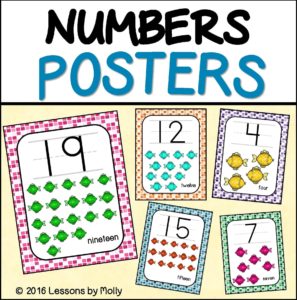
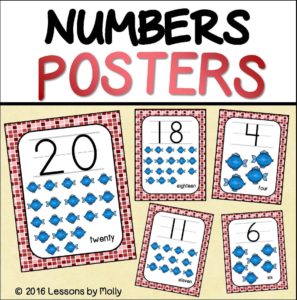 I hope that you are enjoying your summer break! School will be coming soon!
I hope that you are enjoying your summer break! School will be coming soon!
Copyright 2016 Molly McMahon, Lessons by Molly

